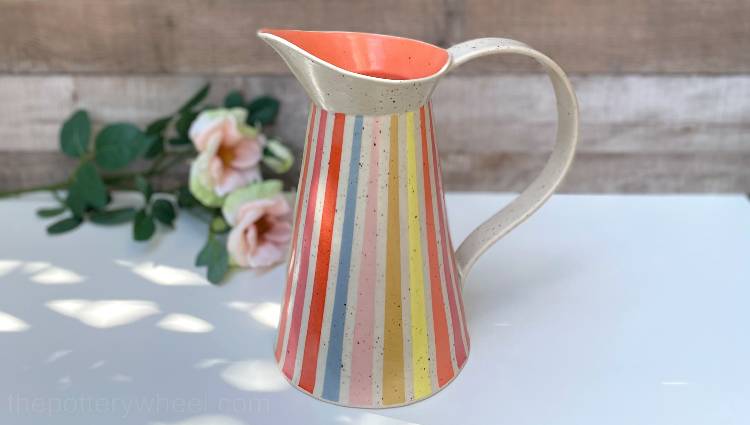Your cart is currently empty!
11 Ways to Identify Delft Pottery | Spotting Real Delftware
Published:
Last Updated:
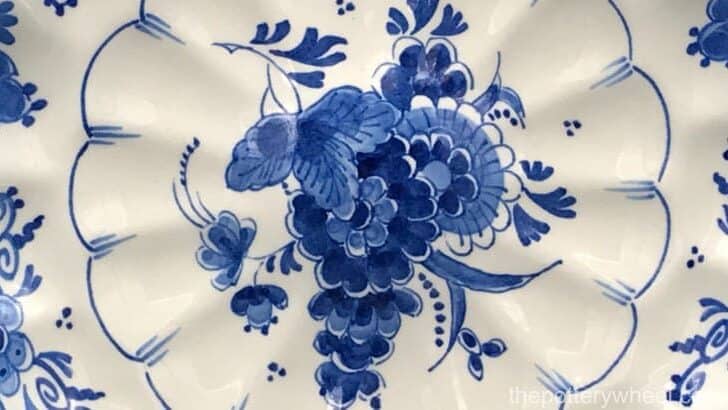
Affiliate Disclaimer
As an affiliate, we may earn a commission from qualifying purchases. We get commissions for purchases made through links on this website from Amazon and other third parties.
If you want to identify Delft pottery, it is helpful to have a checklist of features to look out for. One important way to identify Delft pottery is to look at the marks on the underside of the piece. However, not all Delftware bears a mark, and even when it does, not all of these marks are genuine. So, it’s helpful to have other characteristics to look out for.
In this article, I will look at 11 different features of Delft pottery that will help you identify the real thing.
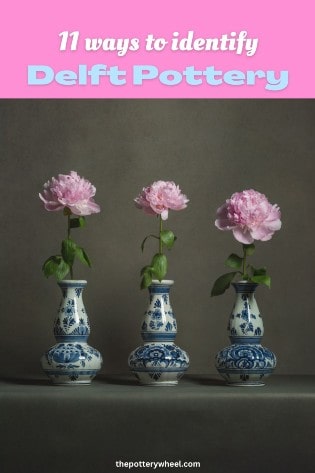
It’s well known that Delft pottery often features blue decoration on a white ceramic body. This is why Delft pottery is sometimes called Delft Blue or Delft Blauw.
However, there are lots of styles of pottery that use a similar blue and white color scheme. So, how do you identify Delft pottery and distinguish it from other blue and white ceramics?
How to Identify Delft Pottery?
Here are some features of Delft pottery to bear in mind when you are sizing up your ceramics.
Tip 1: Delft Pottery is Blue and White (Usually!)
A lot of Delft pottery has a white background with hand-painted blue designs. One of the reasons for this lies in the history of Delft pottery.
In the early 17th century, lots of Chinese porcelain found its way into the Dutch ceramics market. Some of this was imported, and some pieces were taken from some Portuguese cargo ships that had been captured by the Dutch.
Porcelain clay is white, hard, and refined when it has been fired. ‘Firing’ basically means baking the pottery at high temperatures in an oven specifically designed for ceramics. These ovens are called kilns and reach temperatures much higher than a domestic oven.
The decoration on the Chinese porcelain was painted with cobalt oxide which turns blue when it is fired.
Some of the very popular pieces of Chinese porcelain are called ‘Kraak’ porcelain. These are usually large wide white porcelain dishes with blue cobalt oxide painted designs.
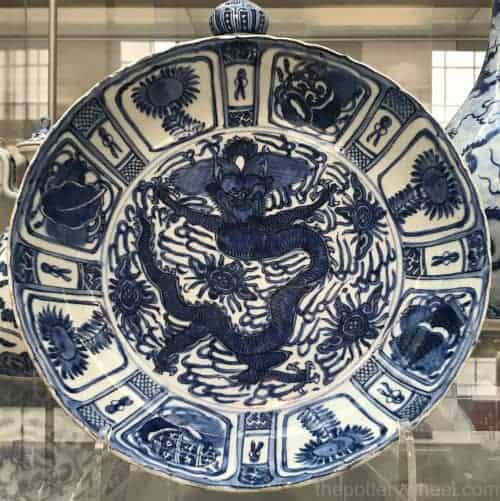
The sides of Kraak porcelain dishes are divided into sections or panels. Each section contains its own decorative design and there is a design in the middle of the dish too.
At this time, Chinese porcelain was very popular in the Netherlands. The Dutch potters struggled to compete with the Chinese imports. So, rather than going out of business, the Dutch potters began to create imitations of Chinese ware.
The Dutch imitations of Chinese porcelain were convincing and had beauty in their own right. It is this influence of Chinese ware that lead to a lot of Delft pottery having its iconic blue and white designs.
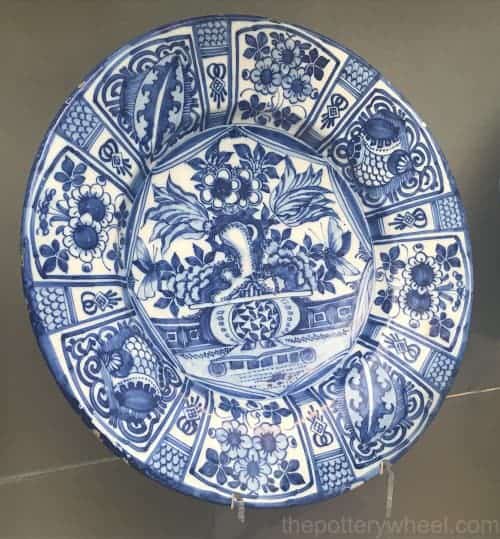
If you would like to know more about the history of Delft pottery you can take a look at my article on its history here.
The Influence of Japanese Porcelain
Chinese porcelain was not the only influential factor that shaped the color schemes used by the Delft potters.
In 1645 there was an interruption in the amount of Chinese porcelain being exported to the Netherlands. To replace the flow of porcelain from China, there was an increase in porcelain that was imported from Japan.
The Japanese porcelain, called Imari porcelain was decorated with a range of colors including blue, red, and gold.
It took the Dutch potters a while to figure out how to fire their pottery in a way that would preserve the bright colors of the enamels being used. However, eventually, they cracked the code and were able to reproduce the rich colors of the Imari porcelain faithfully.
Therefore, whilst a lot of Delft pottery is blue and white, there is also a significant amount of colored Delft pottery that is referred to as ‘polychrome’. This Delft polychrome pitcher is decorated with Chinese-style floral motifs.
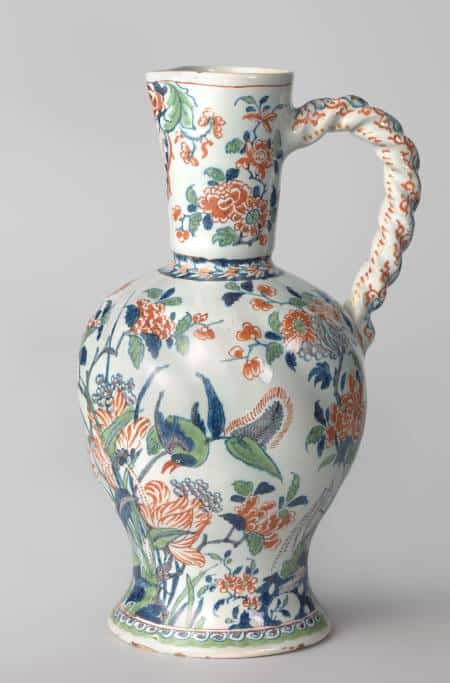
Courtesy of Rijksmuseum (Public Domain)
It’s also worth remembering that not all Delft pottery was decorated at all. Lots of pottery produced by the Delft factories was made as everyday domestic ware.
As such, it was left plain white rather than decorated with the iconic blue colors that we associate Delft pottery with today.
So, you may be wondering, if a lot of Delft pottery is a convincing imitation of Chinese and Japanese porcelain, how do you tell the difference between them? That’s a good question, so let’s take a look at some of the differences now…
Tip 2: The Decoration
Early Dutch imitations of Chinese porcelain were heavily influenced by the Chinese style of decoration. As such, the Delft pottery was Chinese in its color schemes and also in the themes they depicted too.
However, as the Delft potters became established and proficient in the production of these pieces, they began to include Dutch scenes in the designs. These included images of everything from windmills, Dutch landscapes, fishing boats, seascapes, flowers, and hunting scenes.
As a result, the decoration on the Delft pottery became a blend of Chinese color and style with European features. This blend of eastern and western styles is called Chinoiserie.
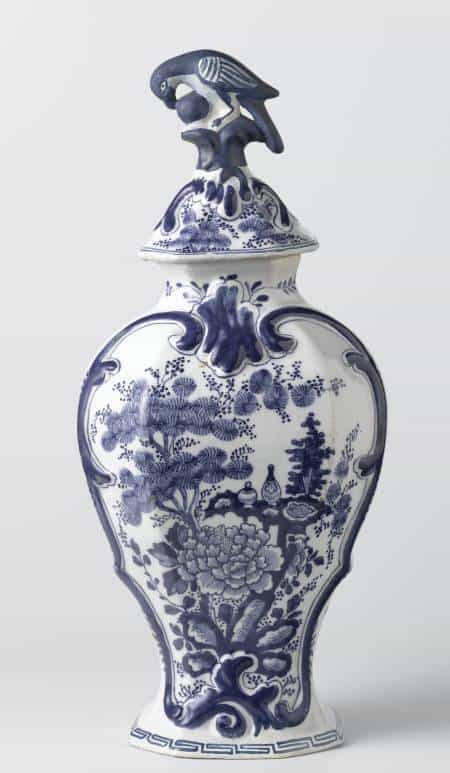
c. 1760-1800.
Courtesy of Rijksmuseum (Public Domain)
If you want to identify Delft pottery, then it’s helpful to look out for a blend of oriental and western themes.
Having said that, finding a blend of Dutch and Chinese or Japanese features doesn’t guarantee that you are looking at Delft pottery.
The Dutch were influenced by the porcelain from the East. But equally, the potters from China and Japan were influenced by Dutch tastes. Because a lot of their porcelain was being exported to the Netherlands, the Chinese and Japanese potters made pieces to suit the Dutch market.
As a result, some Chinese and Japanese porcelain has a Dutch look to it. So, if the Dutch pottery was decorated in a Chinese style, and some Chinese porcelain has Dutch features, how can you tell the difference between the two? Read on, for some more tips about how to distinguish these similar styles…
Tip 3: Delft Pottery is Earthenware not Porcelain
One of the key differences between Delft pottery from Chinese and Japanese pottery is that Delftware is made from earthenware clay. By contrast, the Chinese and Japanese pottery that it was imitating was made from porcelain.
Delft pottery was sometimes called Delft porcelain because it sought to copy the look of porcelain. Some of the factories that made Delft pottery had the word ‘Porcelain’ in their names. For example, The Porcelain Axe (De Porceleyne Byl), and The Three Porcelain Bottles (De Drie Porceleyne Flessies).
And in fact, of the original factories, the one that is still in operation today is called The Porcelain Bottle (De Porceleyne Fles). Although in 1919 it became known, by Royal decree as The Royal Delft.
Nevertheless, Dutch Delft pottery is earthenware. And whilst fired porcelain is very white and refined, the clay used by the Delft potters in the 17th century was a yellowish-cream color.
The off-white earthenware clay, which will often have become more discolored over time, will be visible on unglazed parts of Delft pottery. You can see the discolored earthenware clay showing on the base of this 18th century Delft vase.
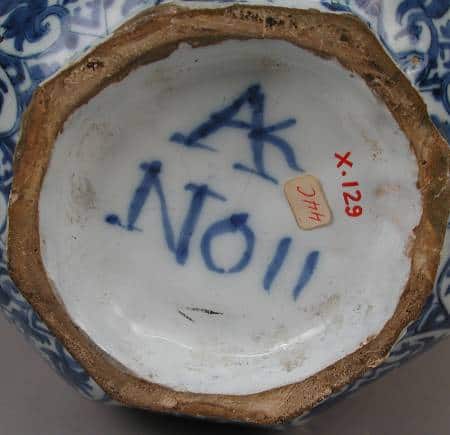
(Public Domain)
This is one helpful way to tell the difference between Chinese porcelain and chinoiserie Delft pottery that has the same colors and similar designs.
But if the earthenware clay that the Delft potters was yellow cream, how did they copy the bright whiteness of Chinese porcelain? This question leads us neatly to one of the next features that will help you identify Delft pottery.
Tip 4: Antique Delft Pottery is Tin Glazed
Another way to identify antique Delft pottery is to look at some features of the pottery glaze. First here is a little bit about the glazing process to help you understand what you are looking for.
The Firing Process
Pottery is normally fired two times. The first firing is called the bisque firing and turns the pottery from fragile soluble clay into hard insoluble ceramic material.
After the clay has been bisque fired, it is painted with liquid glaze. Glaze is basically water that contains, amongst other things, powdered quartz or glass. The liquid glaze dries and forms a coat on the pottery.
It’s then fired for a second time and during the firing, the glaze melts on the surface of the pots. This is called the glaze firing. When the kiln cools down, the glaze turns solid again to form a glassy surface on the pots.
Very few glazes contain lead nowadays because of the health risks it poses. However, in the past lead was commonly used in glaze because it lowered the temperature at which the glass in the glaze melted. It also gave the pottery a lovely glossy finish.
How to Identify the Glaze Used on Delft Pottery
Back in the 16th century, potters in the Netherlands were making pottery made from earthenware clay and glazing it with clear lead glaze.
However, skilled Italian potters who had been working nearby in Antwerp relocated to towns in the north of the Netherlands.
These Italian potters used a glazing process called tin-glazing. Tin glaze was also a lead-based glaze. However, it contained a small percentage of tin oxide, which turned into an opaque white glaze when it was fired.
The white tin glaze provided the perfect base on which to paint detailed decorative designs. This plate below is an Italian tin-glazed earthenware plate dated around 1515.
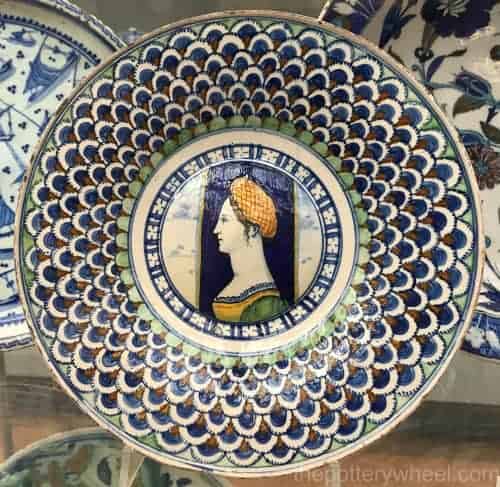
Tin-glazed earthenware. Located at V&A.
When the Italian potters moved to the Netherlands, they introduced the tin glazing process to the Dutch. This enabled the Dutch to cover up the off-white, or sometimes red clay that they were using to make pottery.
Initially the Dutch potters would tin glaze just the top surface of the pottery. Tin glaze was expensive, so they used clear lead glaze on the underside of pieces.
But, when they started trying to copy the Chinese porcelain makers, they started to apply tin glaze all over their pottery, including the underside. This gave the pieces an all-over whiteness that they were striving to achieve.
However, there are a few tell-tale signs that the white pottery made by the Delft potters was tin-glazed earthenware, rather than porcelain. The first sign was that the cream or off-white color of the earthenware clay would show through at points on the glaze.
For example, if the Delft pottery was chipped, the earthenware clay would be visible underneath the white glaze. This leads us to another feature that will help you to identify Delft pottery…
Tip 5: Chips and Damage to the Glaze
Porcelain is very hard and durable. Although it can be damaged through wear and tear, and with age, it usually holds up quite well.
By contrast, earthenware clay is quite soft and fragile and as a result, it chips easily. Most antique Delftware will have some knocks and bumps and damage to the glaze. Finding chips and grazes on the white surface is an indicator that the piece is tin-glazed earthenware also known as faience.
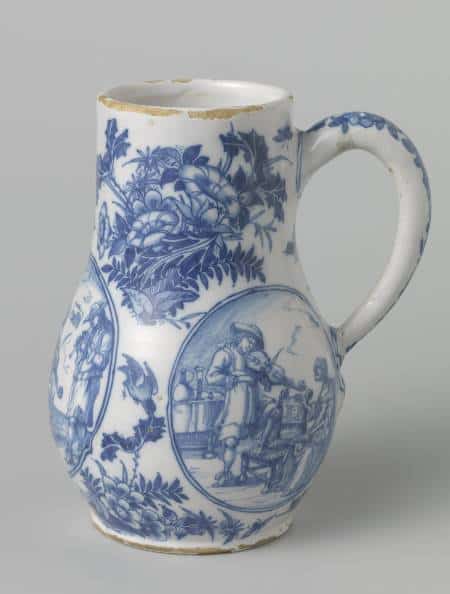
Image courtesy of Rijksmuseum. (Public Domain)
Tip 6: Pinholes in the Glaze
Another feature of tin-glazed pottery is that you will usually find what is called ‘pin holes’ on the glaze at points on the piece.
Pin holes are exactly as they sound, they are small pin-sized holes in glaze. These blemishes are caused when the pottery is fired. Gases escape from either the clay or glaze as the kiln reaches high temperatures.
As the gases leave the pottery through the glaze, they leave pin-sized exit points. These are the pin holes that you see on tin-glazed pottery. This does not affect the value of the pottery.
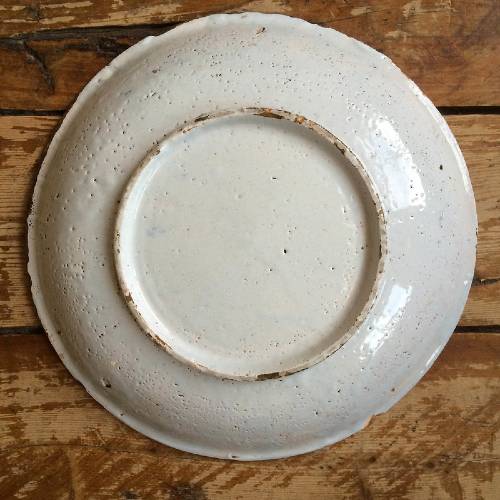
Image by Carl Guderian (CC BY-NC-SA 2.0)
Tip 7: Peg Marks on the Glaze
One final feature that you will find on the glaze of some antique Delft pottery is marks made on the glaze during the firing process. These marks are usually evident on the underside of plates and large wide pieces that have been stacked in the kiln during firing.
To make the most of the space available in a kiln, the pottery was stacked on top of each other during the firing process. However, if you stack glazed items on one another they will weld together in the kiln as the glaze melts.
To avoid the glaze sticking together, plates would be separated in the kiln using pegs. Originally, Delft pottery was fired in wood-burning kilns. The atmosphere in these kilns was full of fumes, smoke, and ash when the pottery was being fired.
The Use of Saggars and Pegs
To protect the glazed pieces from dirt and ash, the pottery was fired in saggars. These are tubular containers made from refractory clay that can cope with high temperatures. They were shaped a bit like large, tall, round biscuit barrels.
Holes were made along the side of the saggar, and pegs could be inserted through the holes. The saggars were loaded with plates. The first plate was loaded and rested on some pegs that were sticking through the side of the saggar.
Then some more pegs were inserted just a little bit higher up the saggar. A second plate was then loaded and placed carefully on the second row of pegs. This process continued until the saggar was full. Each plate would be resting carefully on three pegs.
The image below is a picture of a perspex model of the saggars used for firing Delft pottery. You can see how the pegs were inserted in holes at three points around the cylinder.
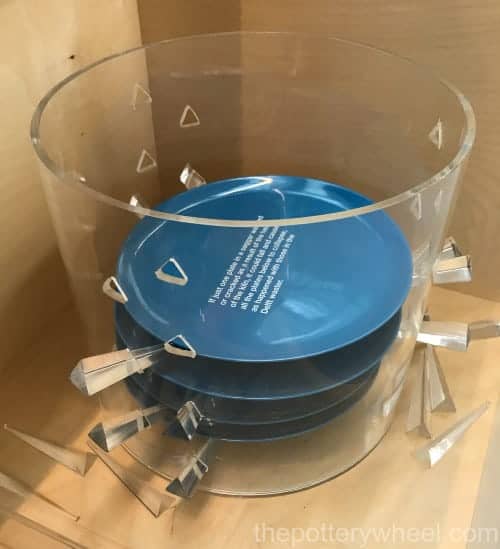
The pegs prevented the plates from touching each other during the glaze firing. However, as the pieces were fired, the pegs would get stuck to the underside of the plate. These would need to be carefully snapped off after the kiln had cooled and the saggars were unloaded.
As a result, original tin-glazed Delft pottery will have three scars in the glaze on the underside edge of plates. If you spot these on a piece of pottery, then it gives you an indication that it was wood-fired in a saggar resting on pegs.
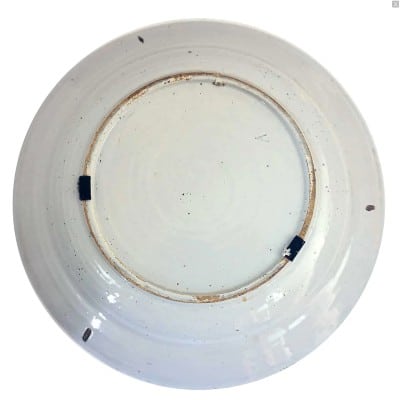
Image courtesy of Eron Johnson Antiques
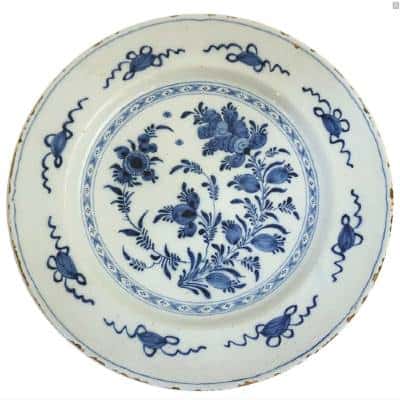
Image courtesy of Eron Johnson Antiques
Changes in How Delft Pottery was Glazed
Initially, the glazing process involved coating the Delft pottery with tin glaze, painting decoration in colored oxides onto the glaze, and then firing the pieces.
However, after a while, another step was introduced. Once the tin glaze had been decorated a second coat of clear lead glaze was applied to the decorations. It was found that this additional coat of glaze gave the Delft pottery a high gloss finish that was similar to the finish found on porcelain pieces.
But this process was complicated and expensive. And in the latter half of the 19th century, there was a move away from tin glazing(1).
Joost Thooft had taken over running De Porceleyne Fles. He was experimenting and innovating with techniques to reduce costs and also perfect the decorating and glazing process.
One of the changes that he introduced was to make the Delft pottery in a manner that was closer to how Wedgewood pottery was being made(2). They adjusted the ingredients being used to make the clay and started to make their pieces with white-firing clay.
This removed the need for tin glazing. Instead, the pottery was shaped, and then coated with a white-colored clay slip called engobe. Clay slip is simply clay particles suspended in water to make a liquid form of clay.
This was then bisque fired and once it was ceramic the pieces were painted with underglaze colors. A clear glaze was then applied to the decorated ceramics and fired a second time.
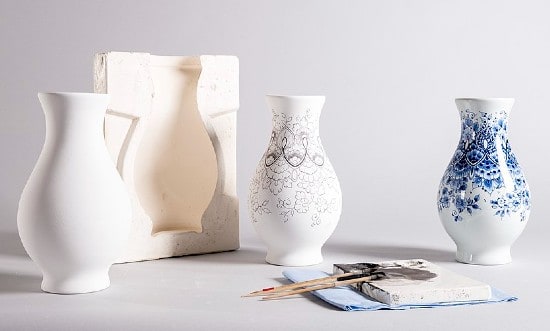
Anneteoshea, CC BY-SA 4.0, via Wikimedia Commons
De Porceleyne Fles is still operating today and this is the process that they still used today to make their Delft pottery. If you’d like to know more about exactly how Delft pottery is made, you can check out my article on that here.
Tip 8: Delft Pottery Markings
If you are trying to identify Delft pottery, you might hope to turn the piece over and find a straightforward mark on the base that would indicate whether or not it is Delftware.
The reality is it’s not quite as simple as that for the following reasons…
- In the height of its production in the 17th century, the majority of Delftware being made was not marked by the factory producing it. A lot of it was being made for everyday use and left the factory with no markings.
- The pottery marks used by different factories changed over the years. So, each factory will have numerous different designs, which can be confusing.
- More recently there has been a growth in the number of factories that mass produce pottery and then put a misleading label or mark on the base that would suggest it’s Delft pottery.
Most of this isn’t handmade or painted and some of it is produced in China and shipped back to the Netherlands.
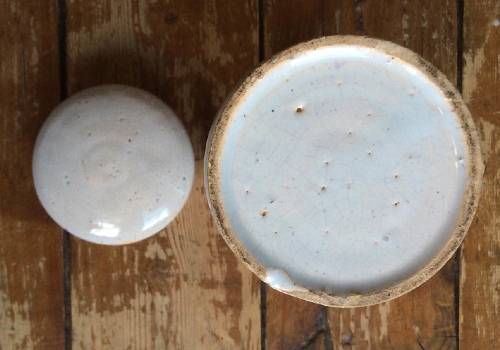
That being said, when an object does have markings on the base, they can be very helpful in trying to figure out when, where and who made the piece.
Variations in Delft Pottery Markings
By the end of the 17th Century there were over 30 factories in Delft producing Delft pottery. And each different factory had its own markings.
In addition to this, the marks made by different factories would change as the factories changed hands and came under new ownership. So, as you can imagine, there are lots of different Delft pottery marks.
Simple Drawings
Sometimes the markings were icons that were designed to represent the factory itself. A good example of this is The Three Bells (De Drie Klokken) factory which was established in 1671.
The marking for The Three Bells was sometimes just a simple drawing of three bells.
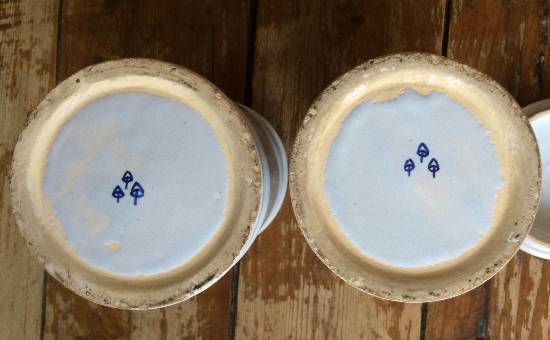
Image courtesy of Carl Guderian, (CC BY-NC-SA 2.0)
Another example of a simple graphic icon is that used at times by The Claw (De Klaauw) which was established in 1661.
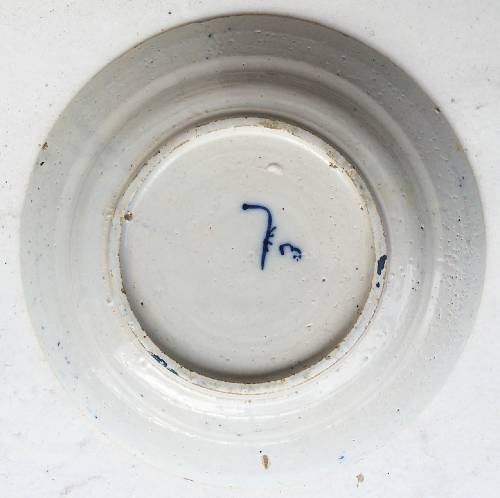
Image courtesy of Carl Guderian, (CC BY-NC-SA 2.0)
Lettering and Initials
At other times more information was included in the markings. For example, an image might be used to represent the factory. And then letters were used under the image to indicate who owned the factory at the time.
An example of this was the marking used by The Greek A (De Grieksche A) factory at the time when it was owned by J T Dextra between 1758 and 1764.
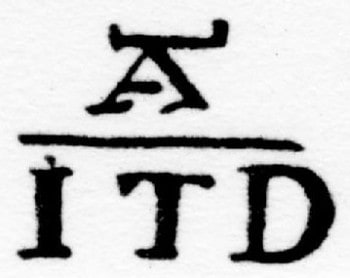
Public Domain, via Wikimedia Commons
The symbol on the top is one of the symbols used by The Greek A factory. And the initials underneath JTD refer to the owner Jan Theunis Dextra at the time.
Additional Markings
Over time the pottery markings became more complicated and contained more information. This was partly to prevent reproductions of pieces with false marks passing themselves off as Delft pottery. However the range of markings can make it harder, or at least more confusing when trying to identify Delft pottery.
An example of a more detailed Delft pottery mark is the one used by De Porceleyne Fles (The Porcelain Bottle) also known as The Royal Delft. This factory is the last of the original factories established in the 17th century that is still in operation.
The marking for De Porceleyne Fles includes a simple drawing of a small bottle. Underneath are the initials JT for Joost Thooft who owned the factory between 1876 and 1884. These initials are intertwined so they look a little bit like a backward F.
Below the initials JT is written the word ‘Delft’ which is written in a particular style. And finally on the bottom left are the initials of the painter and on the bottom right is a year code. This mark for De Porcelyne Fles continues to be used today.
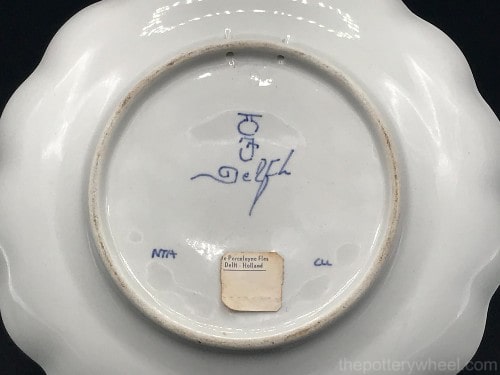
The elements that make up the marking for De Porceleyne Fles are the company’s trademark. This was officially registered in 1879(3).
As with the other factories, the pottery mark for De Porceleyne Fles changed over the years. For example, the factory was owned by Jacobus Harlees between 1771 and 1786. Later between 1786 and 1804, his son Dirk Harlees ran the factory.
Sometimes objects from the Harlees period were signed just with the initials HL and other times they also used an icon of the small bottle.
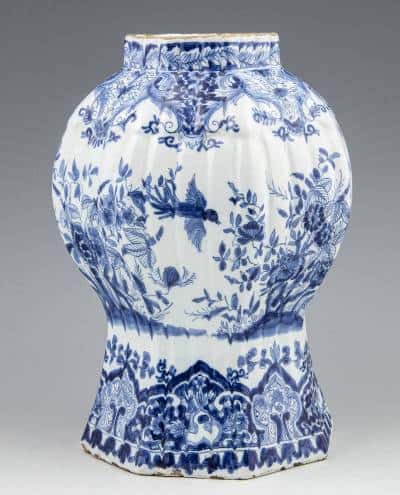
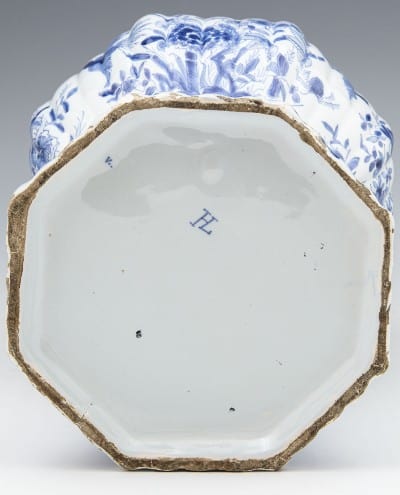
If you would like to know more about Delft pottery marks, you can check out my article on them here.
Tip 9: Spotting ‘real’ Delftware
From the 20th century onwards, there was a growth in the mass production of ceramics. In addition to this, there was a big surge in tourism which lead to an increase in demand for ceramics that looked like Delftware but which was less costly.
As a result, there are a lot of ceramics available with designs that have been inspired by original Delftware. However, they are not made using the original production techniques that have a high level of skill and craftsmanship. If you’d like to know more about how Delft pottery is made you can check out my article on that subject right here.
Copies of Delftware are generally not hand-painted. Sometimes these pieces are made in Chinese factories and shipped back to the Netherlands to be sold to tourists. They may have writing on the bottom that says it is ‘hand painted’.
What this often means is that some small detail on the piece has been hand-painted. However, the rest of the design is a printed transfer. For example, only the clouds on a landscape may have been hand-painted on an otherwise printed design.
They may also have the words ‘Delft’, ‘Delfts’, ‘Delftsware’ or ‘Delft Blauw’ written on the base. It’s not possible to trademark the use of the word ‘Delft’, so adding the word ‘Delft’ to the base of a piece will encourage the buyer to think that they are purchasing an original piece of Delftware.
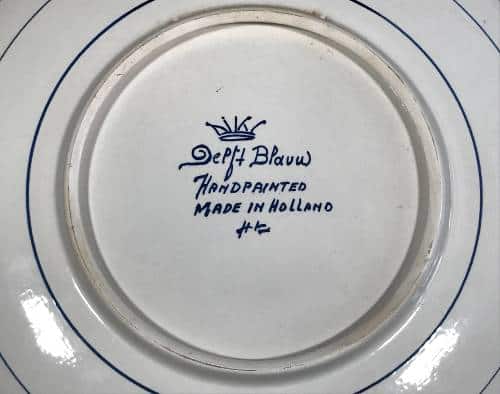
In addition to this, a modern copy of Delftware might have other words painted or printed on the bottom, such as ‘handmade’ or ‘hand painted’. These words are an indication that the piece was not made by one of the original Delft factories. And also that it has most likely been mass-produced rather than being hand made using the original techniques.
Tip 10: Spotting ‘Antique’ Delftware
Antique dealers usually agree that an object becomes antique once it is 100 years old or more. Items that are between 50 and 100 years old are normally described as vintage (source).
As mentioned above tin-glazing was phased out as a way of glazing Delft pottery in the latter half of the 19th Century. So, it’s safe to say that if you have a piece of tin-glazed delftware, then you most likely have an antique.
In addition to inspecting the pottery glaze, look at how the pottery mark has been applied. Usually, pottery marks are carefully painted onto the base of a genuine piece of Delftware using a fine brush. Sometimes genuine Delft pottery marks were lightly impressed into the clay(4). But for the most part, they were painted on.
If you have a piece of pottery that is marked as ‘Delft’ but the marking has been printed on, using a stamp then it’s likely that this is a modern reproduction of Delftware.
You might also find a piece of pottery that has a sticker on the base stating that it is Delftware. These are also most likely to be ceramics that have been mass-produced rather than hand-crafted.
Some antique Delftware will have stickers on the base. But these are normally stickers that have been added by museums, dealers, or auction houses to help them categorize their objects. As such, the stickers supplement the markings that have been painted on the base.
Tip 11: Delftware Made Outside Delft
One of the tricky things about trying to identify Delft pottery is that the potters in Delft inspired other cities in the Netherlands to produce similar work.
For example, factories in cities such as Amsterdam, Makkum, and Rotterdam produced ceramics that was similar in style to Delft pottery.
In addition to this, Delft-style pottery was produced in other countries. One of the other most notable forms of Delft-style pottery produced outside of the Netherlands was produced in Britain. This has come to be known as English Delftware.
There are some differences in style between English and Dutch Delftware. For example, some English Delftware reflects English pastoral themes. The plate below is similar to Kraak porcelain, but the decorations reflect English themes.
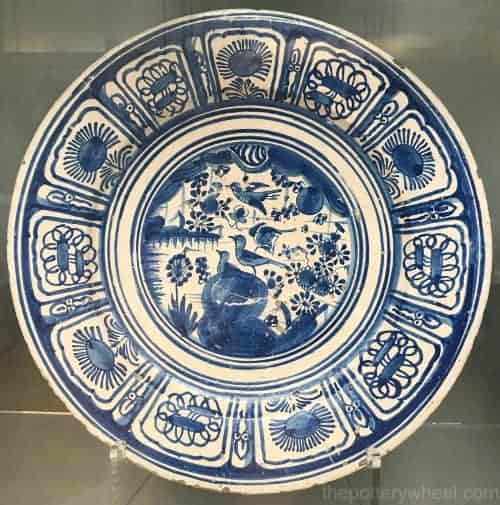
However, some English Delftware is very similar in style to Dutch Delft. You may find a piece of pottery that looks very much like Dutch Delftware, only to find on closer inspection that it was actually made in England. So, this is something to be mindful of if you want to identify Dutch Delft pottery.
Final Thoughts
It’s a thrill when you stumble across a piece of pottery that looks like it has an interesting history. Trying to figure out where it was made and by whom can feel like a puzzle. However, if you think you have some Delftware, you can use the features outlined above to help you identify whether it is Delft pottery and if so, how old it is.
References:
1, 2, &3) Royal Delft, A Guide to De Porceleyne Fles. Erickson, E.

